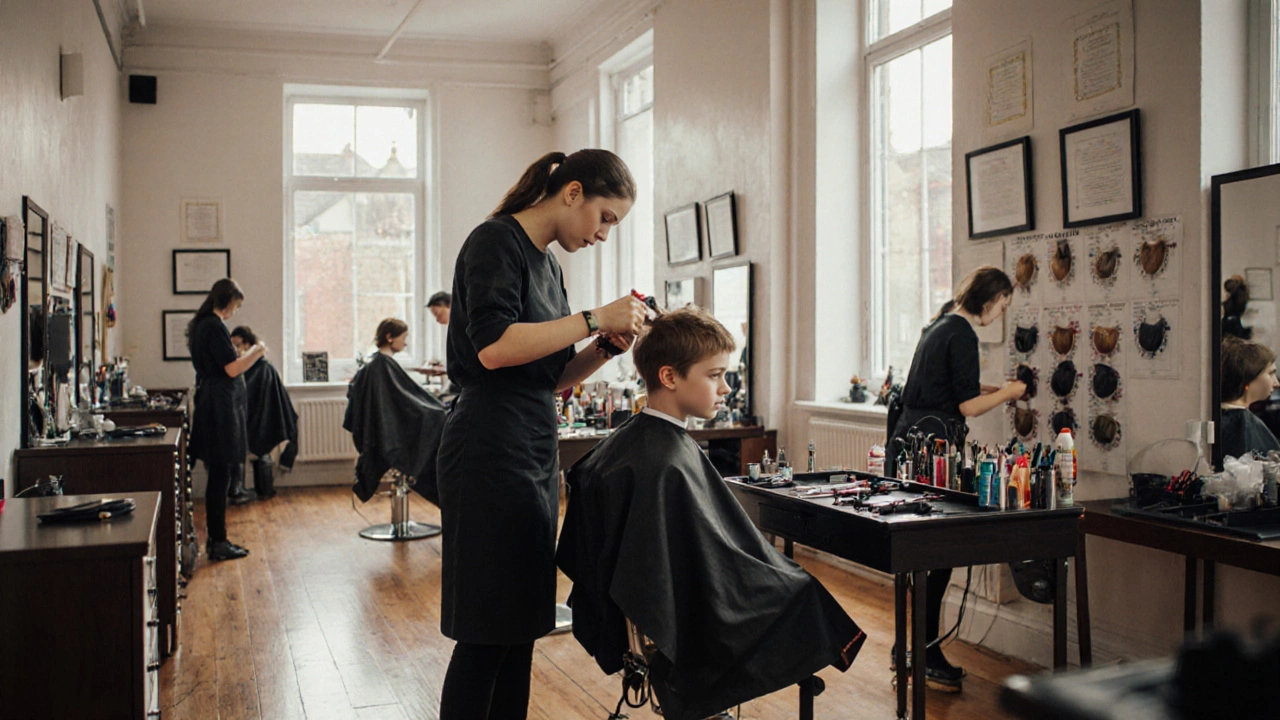How long does it actually take to become a qualified hairdresser? If you’re thinking about switching careers or starting out fresh, the answer isn’t simple. It depends on what kind of qualification you want, how much time you can commit, and whether you’re learning full-time or part-time. There’s no one-size-fits-all timeline-but here’s what really happens on the ground in 2025.
Full-Time Hairdressing Courses: 6 to 12 Months
If you’re studying full-time at a college or private training academy, most entry-level hairdressing courses take between six and twelve months to complete. These are usually Level 1 or Level 2 NVQs in Hairdressing, which are the standard qualifications employers look for in the UK.
At colleges like City of Bristol College or West London College, a full-time Level 2 course runs for about nine months. You’ll spend three to four days a week in the salon or training room, learning cuts, colouring, blow-drying, and client consultation. The rest of the time is spent on theory, exams, and building your portfolio. By the end, you’ll have enough skills to work as a junior stylist in a salon.
Some accelerated programs claim to finish in six months, but they’re intense. You’ll be in class or on the floor for 30+ hours a week, with little room for error. These are best for people who can focus completely and have some prior experience-like helping friends with hair or working in a salon reception.
Part-Time and Evening Courses: 12 to 24 Months
If you’re working another job, raising kids, or studying something else, part-time options are more realistic. Evening classes or weekend courses stretch the same curriculum over a year or two.
Many adult learners in places like Cardiff, Manchester, or Bristol choose this route. At a typical community college, you might attend two evenings a week (6-8 hours total) and one Saturday a month. That adds up to about 15-20 hours of training per month. It takes longer, but it’s sustainable. Most people finish their Level 2 qualification in 18 to 24 months this way.
One downside: you’ll progress slower. If you miss a session on colour theory, you might struggle later when applying it in the salon. Consistency matters more than speed here.
Apprenticeships: 12 to 18 Months (Earn While You Learn)
The most popular path for young people under 25 is an apprenticeship. You’re hired by a salon as a trainee and get paid while you learn. Apprenticeships combine on-the-job training with weekly college sessions.
Most apprenticeships last 12 to 18 months. You’ll start by washing hair, brushing clients’ shoulders, and cleaning tools. Within three months, you’ll be cutting under supervision. By the end, you’ll be doing full services-cuts, colour, styling-with confidence.
Salons like Salon 11 in Bristol or The Cut Collective in Brighton offer structured apprenticeships that lead directly to a Level 2 NVQ. Many apprentices get hired full-time after finishing. In fact, 72% of apprentices in the UK stay with their training salon, according to the Skills for Hair and Beauty report from 2024.

What About Level 3? Advanced Training Takes More Time
Level 2 gets you a job. Level 3 gets you promoted.
After completing your Level 2, you can move on to Level 3 qualifications in Advanced Hairdressing. This covers complex techniques like colour correction, extensions, bridal styling, and men’s grooming. It’s not mandatory-but if you want to be a senior stylist, trainer, or salon owner, you’ll need it.
Level 3 courses take another 6 to 12 months, depending on whether you study full-time or part-time. Many stylists do this while working, squeezing in college days on slow weekdays. Some salons even pay for your Level 3 training as a retention perk.
Short Courses and Workshops: Not Qualifications, But Useful
You might see ads for “7-day hair colour masterclass” or “3-day extensions certification.” These aren’t formal qualifications. They’re short workshops designed to add skills to your existing toolkit.
They’re great if you’re already working and want to learn keratin treatments, balayage, or scalp micropigmentation. But they won’t get you hired as a junior stylist. Employers still require an NVQ Level 2 or equivalent.
Think of them like upgrading your tools. You need a hammer before you buy a nail gun.
What You Need Before You Start
You don’t need prior experience to begin a Level 1 course. But you do need:
- Basic literacy and numeracy-you’ll need to read client forms, understand product instructions, and calculate colour ratios.
- Good hand-eye coordination-you’re working with scissors, chemicals, and heat tools.
- A willingness to stand for hours-salon work is physically demanding.
- Patience with clients-some people are nervous, others are demanding. You’ll learn how to handle both.
Many training providers offer a free taster day. Use it. Try cutting a mannequin head. See if you enjoy the pace. If you hate standing for eight hours straight, this isn’t the job for you.

Costs and Funding: What You’ll Pay
Full-time college courses cost between £1,500 and £3,500, depending on the provider and location. Apprenticeships are free-you get paid. Some local councils offer grants for adult learners, especially if you’re unemployed or on benefits.
There’s also government funding through the Advanced Learner Loan. You don’t pay back until you earn over £27,295 a year. And if you complete your course and work in the industry for two years, you might qualify for partial loan forgiveness.
How Long Until You’re Employed?
Most graduates land their first job within two weeks of finishing. Salons are always hiring. The UK has a shortage of qualified stylists-especially in smaller towns and suburbs.
But don’t expect to walk in and start doing high-end colour jobs. Your first job will likely be as a junior stylist or assistant. You’ll wash hair, assist senior stylists, and build your client base slowly. It takes 12 to 18 months of real-world experience to become truly confident.
One stylist in Bristol told me: “I passed my NVQ in December. By March, I was doing cuts. By July, I had my own chair. By next year, I was training new apprentices.” That’s the typical path.
What Comes After the Course?
Getting your qualification is just the start. The real learning happens in the salon.
Top stylists keep learning. They take workshops on new techniques. They follow Instagram trends. They study product chemistry. Some even go back for Level 4 qualifications in salon management or teaching.
There’s no finish line. But if you’re willing to show up every day, learn from your mistakes, and care about your clients-you’ll build a career that lasts.
How long does a hairdressing course take to complete?
A full-time hairdressing course typically takes 6 to 12 months to complete, depending on the level. Level 2 NVQs-the most common entry-level qualification-usually last 9 months. Part-time courses can take 18 to 24 months. Apprenticeships run 12 to 18 months and include paid work in a salon.
Can I do a hairdressing course while working?
Yes. Many colleges offer evening and weekend courses for working adults. You can also do an apprenticeship, where you work in a salon while studying part-time. These options take longer-often 18 to 24 months-but let you earn money while you learn.
Do I need prior experience to start a hairdressing course?
No. Most Level 1 and Level 2 courses accept beginners with no experience. You’ll start with basics like shampooing, brushing, and safety. But having good hand-eye coordination and patience helps. Many providers offer free taster sessions so you can try it out before committing.
Are short hairdressing workshops worth it?
They’re useful if you’re already qualified and want to learn new techniques like balayage or extensions. But they’re not replacements for formal qualifications. Employers require an NVQ Level 2 or higher to hire you as a stylist. Short courses are upgrades, not entry tickets.
How much does a hairdressing course cost?
Full-time college courses cost between £1,500 and £3,500. Apprenticeships are free-you get paid while you learn. You can also apply for an Advanced Learner Loan, which you only repay once you earn over £27,295 a year. Some local councils offer grants for adults returning to training.
What’s the difference between Level 2 and Level 3 hairdressing courses?
Level 2 qualifies you to work as a junior stylist. You’ll learn basic cuts, colouring, and styling. Level 3 is advanced-it covers complex techniques like colour correction, extensions, and bridal work. It’s required if you want to become a senior stylist, trainer, or salon owner. Most people do Level 3 after gaining some work experience.
If you’re serious about becoming a stylist, start by visiting a local college or salon that offers apprenticeships. Ask to shadow someone for a day. See the rhythm of the job. Talk to stylists about their paths. The real secret? It’s not about how fast you finish the course-it’s about how much you keep learning after.





Write a comment